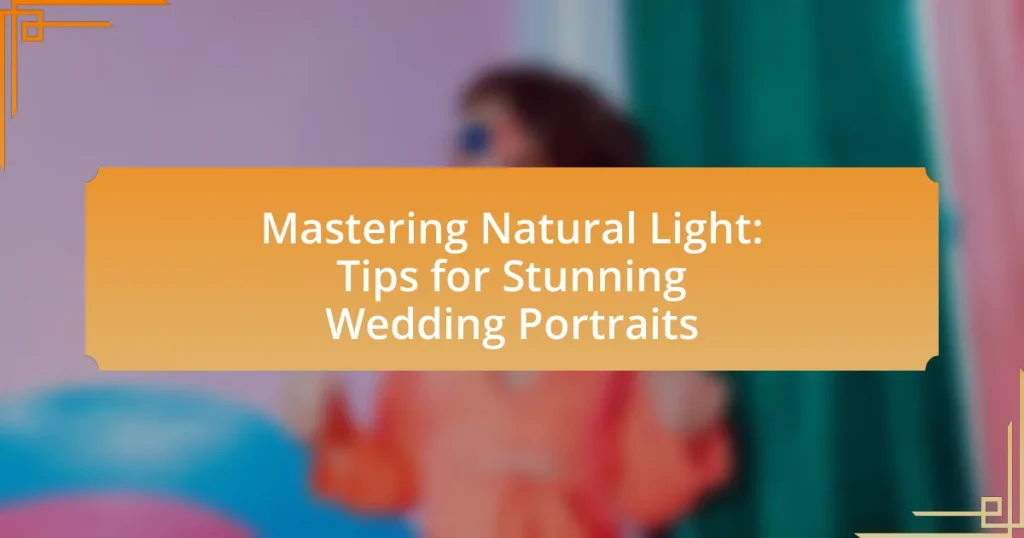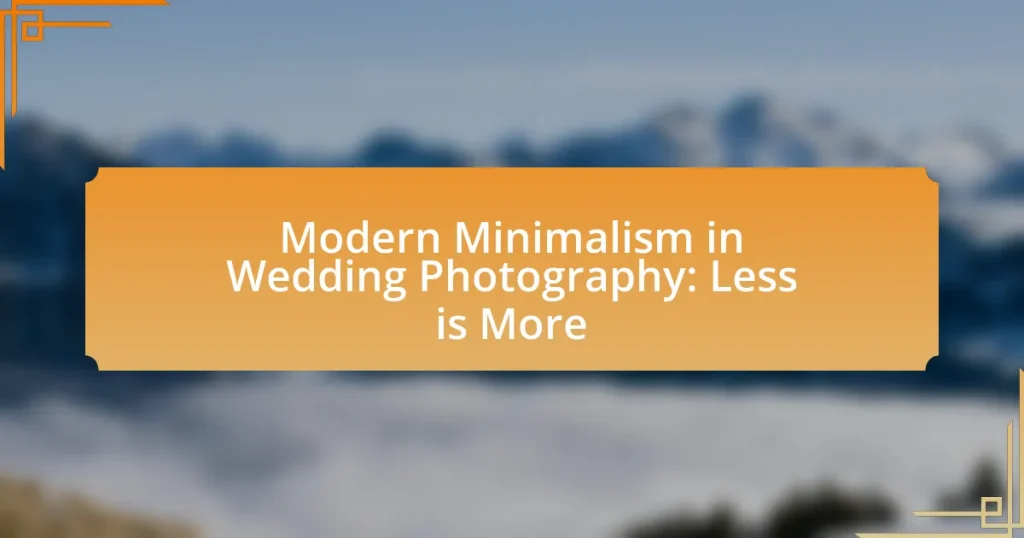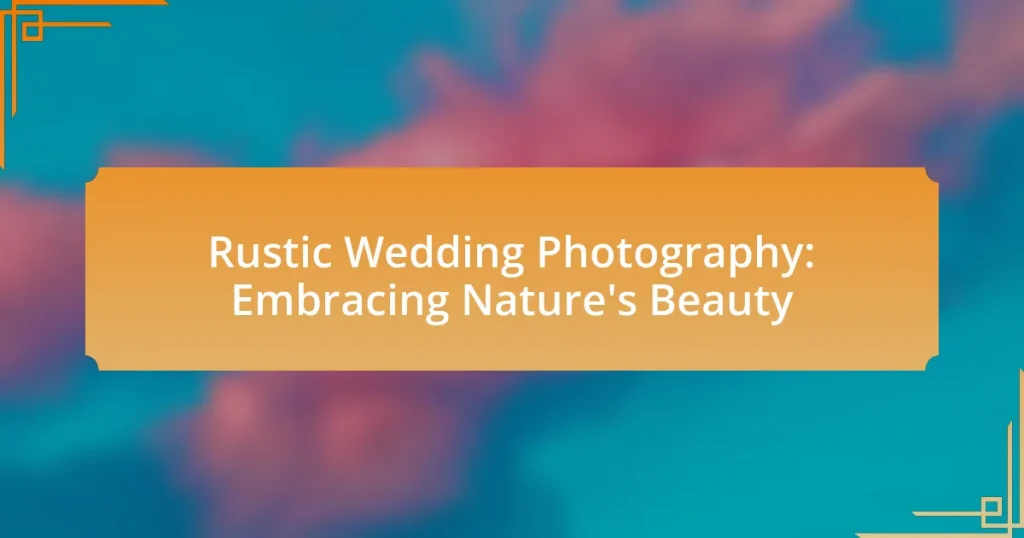The article “Mastering Natural Light: Tips for Stunning Wedding Portraits” focuses on the importance of natural light in wedding photography, highlighting its ability to enhance image quality and capture genuine emotions. It discusses how different qualities of natural light, such as intensity and direction, influence the mood of portraits and the overall aesthetic of wedding images. The article provides practical techniques for photographers to effectively utilize natural light throughout the day, including tips for shooting during golden hour, managing harsh midday sunlight, and employing tools like reflectors and diffusers. Additionally, it addresses common challenges photographers face with natural light and offers strategies to overcome them, ensuring that wedding portraits are both visually appealing and authentic.
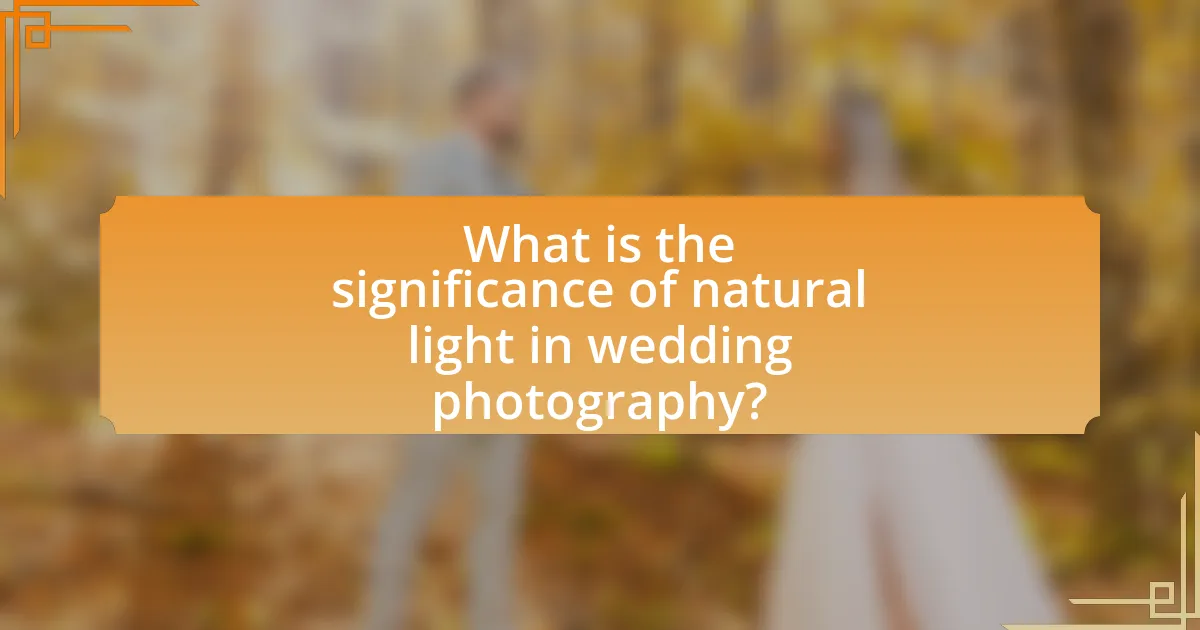
What is the significance of natural light in wedding photography?
Natural light is significant in wedding photography because it enhances the aesthetic quality of images, creating a soft and flattering look. The use of natural light allows photographers to capture genuine emotions and moments without the harshness of artificial lighting. Studies show that images taken in natural light often exhibit better color accuracy and dynamic range, which contributes to a more vibrant and lifelike representation of the wedding day. Additionally, natural light can create beautiful effects such as lens flares and soft shadows, adding depth and dimension to photographs.
How does natural light influence the mood of wedding portraits?
Natural light significantly influences the mood of wedding portraits by creating a soft, flattering ambiance that enhances emotional expression. The quality of natural light, such as golden hour sunlight, produces warm tones that evoke feelings of romance and joy, while overcast conditions can create a more subdued, intimate atmosphere. Studies in photography indicate that natural light can reduce harsh shadows and highlight details, contributing to a more aesthetically pleasing image. This interplay of light and mood is crucial for capturing the essence of the wedding day, as it directly affects how emotions are portrayed in the photographs.
What are the different qualities of natural light that affect photography?
The different qualities of natural light that affect photography include intensity, color temperature, direction, and diffusion. Intensity refers to the brightness of the light, which can create varying moods and contrasts in images; for example, harsh midday sun produces strong shadows, while soft morning light offers a gentle glow. Color temperature affects the warmth or coolness of the light, influencing the overall tone of the photograph; daylight typically has a color temperature around 5500K, while golden hour light is warmer, around 3000K. Direction of light impacts how subjects are illuminated, with front lighting reducing shadows and backlighting creating silhouettes. Diffusion, which occurs when light is scattered by clouds or other materials, softens shadows and reduces contrast, enhancing the overall quality of the image. Each of these qualities plays a crucial role in shaping the final outcome of a photograph, particularly in the context of wedding portraits where capturing the right mood and atmosphere is essential.
How can the time of day impact natural light conditions?
The time of day significantly impacts natural light conditions by altering the angle, intensity, and quality of sunlight. During morning and late afternoon, known as the golden hours, sunlight is softer and warmer, creating flattering conditions for photography. In contrast, midday light is harsher and can produce unflattering shadows and highlights. Studies in photography emphasize that the angle of sunlight changes throughout the day, affecting how light interacts with subjects, which is crucial for capturing stunning wedding portraits.
Why should photographers prioritize natural light over artificial lighting?
Photographers should prioritize natural light over artificial lighting because it creates a more authentic and flattering representation of subjects. Natural light offers a soft, diffused quality that enhances skin tones and reduces harsh shadows, making it particularly effective for capturing wedding portraits. Studies have shown that images taken in natural light often evoke a sense of warmth and intimacy, which is essential in wedding photography. Additionally, natural light is readily available and requires no setup time, allowing photographers to focus on composition and capturing candid moments.
What are the advantages of using natural light for wedding portraits?
Using natural light for wedding portraits offers several advantages, including enhanced skin tones, softer shadows, and a more authentic atmosphere. Natural light creates a flattering effect on skin, reducing harsh contrasts that artificial lighting can produce. Additionally, it allows for a variety of settings and moods, as the quality of light changes throughout the day, providing photographers with diverse options for capturing unique moments. Studies in photography emphasize that natural light can evoke emotions and create a sense of intimacy, making the portraits feel more genuine and connected to the environment.
How does natural light enhance the authenticity of wedding photos?
Natural light enhances the authenticity of wedding photos by providing a soft, natural glow that captures genuine emotions and moments. This type of lighting reduces harsh shadows and creates a more flattering appearance on skin tones, allowing the true essence of the couple and their surroundings to shine through. Studies in photography indicate that natural light can evoke a sense of warmth and intimacy, making images feel more relatable and real. For instance, photographers often prefer golden hour lighting, which occurs shortly after sunrise or before sunset, as it produces a magical quality that enhances the emotional depth of wedding images.
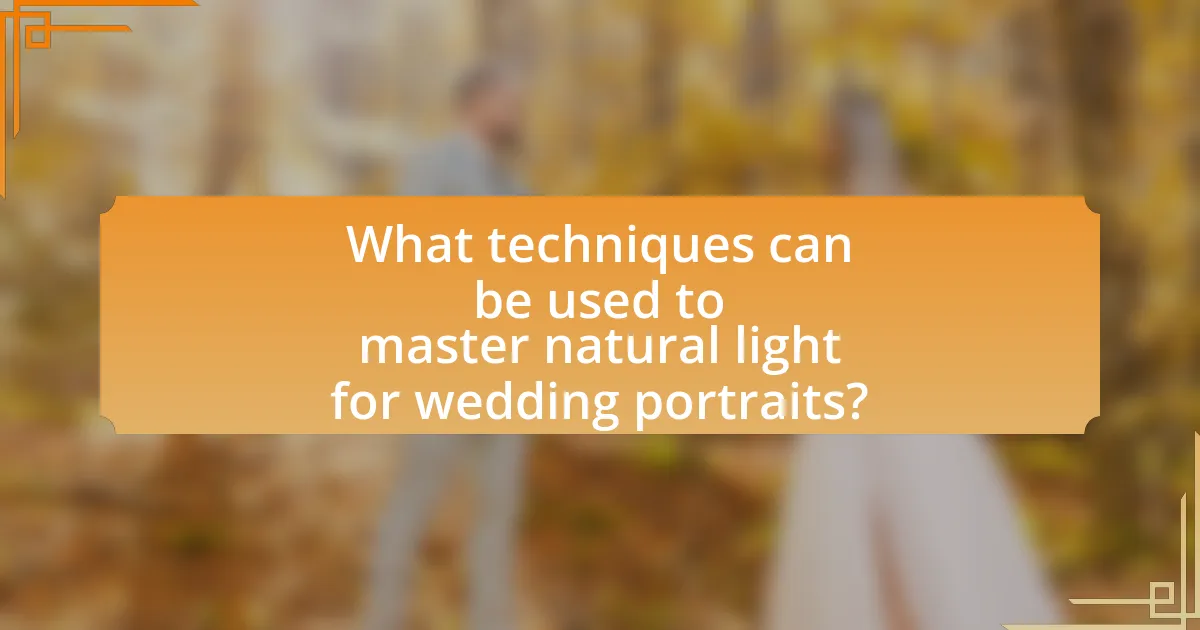
What techniques can be used to master natural light for wedding portraits?
To master natural light for wedding portraits, photographers can utilize techniques such as understanding the golden hour, using reflectors, and adjusting angles. The golden hour, occurring shortly after sunrise and before sunset, provides soft, diffused light that enhances skin tones and reduces harsh shadows. Using reflectors can bounce light onto the subjects, filling in shadows and creating a more balanced exposure. Additionally, adjusting the camera angle to capture light at different positions can help in achieving the desired mood and effect in the portraits. These techniques are widely recognized in photography for their effectiveness in utilizing natural light to create stunning images.
How can photographers effectively use natural light during different times of the day?
Photographers can effectively use natural light during different times of the day by understanding the quality and direction of light at each time. During the golden hour, shortly after sunrise and before sunset, the light is soft and warm, ideal for creating flattering portraits. Midday light, while harsh, can be utilized by finding shaded areas to diffuse the light, reducing shadows on the subject’s face. In the late afternoon, the light becomes softer again, allowing for vibrant colors and dynamic shadows. Photographers should also consider the weather; overcast days provide even lighting, which is excellent for portraits. Studies show that natural light significantly enhances the aesthetic quality of photographs, making it essential for capturing stunning wedding portraits.
What are the best practices for shooting during golden hour?
The best practices for shooting during golden hour include positioning subjects to take advantage of the soft, warm light, using reflectors to enhance illumination, and adjusting camera settings to capture the dynamic range of colors. Photographers should aim to shoot within the first hour after sunrise or the last hour before sunset, as this period provides the most flattering light. Additionally, utilizing backlighting can create a beautiful halo effect around subjects, enhancing the overall aesthetic of wedding portraits. Studies show that images taken during golden hour exhibit richer colors and softer shadows, making them visually appealing.
How can photographers adapt to harsh midday sunlight?
Photographers can adapt to harsh midday sunlight by utilizing diffusers, reflectors, and adjusting their shooting angles. Diffusers soften the light, reducing harsh shadows and glare, while reflectors can bounce light onto subjects to fill in shadows. Additionally, shooting during the golden hour, which occurs shortly after sunrise or before sunset, provides softer, more flattering light. Studies show that light quality significantly impacts portrait outcomes, with softer light enhancing skin tones and reducing contrast.
What are some composition tips for utilizing natural light in portraits?
To effectively utilize natural light in portraits, position your subject near a window or in open shade to achieve soft, flattering illumination. This technique minimizes harsh shadows and highlights, creating a more even light distribution across the subject’s face. Additionally, consider the time of day; shooting during the golden hour—shortly after sunrise or before sunset—provides warm, diffused light that enhances skin tones and adds depth to the image. Using reflectors can also help bounce light onto the subject, filling in shadows and adding dimension. These methods are supported by photography principles that emphasize the importance of light quality and direction in portrait composition.
How can framing and angles enhance the use of natural light?
Framing and angles can significantly enhance the use of natural light by directing and controlling how light interacts with subjects in wedding portraits. Proper framing allows photographers to position subjects in relation to light sources, such as windows or outdoor sunlight, maximizing the illumination on the subject’s face while minimizing harsh shadows. Additionally, using angles can create depth and dimension, allowing light to wrap around the subject, which adds a three-dimensional quality to the image. For instance, shooting from a lower angle can capture sunlight filtering through trees, creating a soft, ethereal glow around the couple. This technique not only highlights the natural beauty of the scene but also emphasizes the emotional connection between the subjects, resulting in more compelling and visually striking portraits.
What role does background play in natural light photography?
Background plays a crucial role in natural light photography by influencing the overall composition and emotional impact of the image. A well-chosen background can enhance the subject, create depth, and provide context, while a cluttered or distracting background can detract from the main focus. For instance, in wedding portraits, a serene landscape or an elegant architectural feature can complement the couple’s attire and the mood of the event, leading to more visually appealing photographs. Studies in photography emphasize that backgrounds should harmonize with the subject to evoke the desired feelings and narratives, thereby validating the importance of background selection in achieving stunning results.
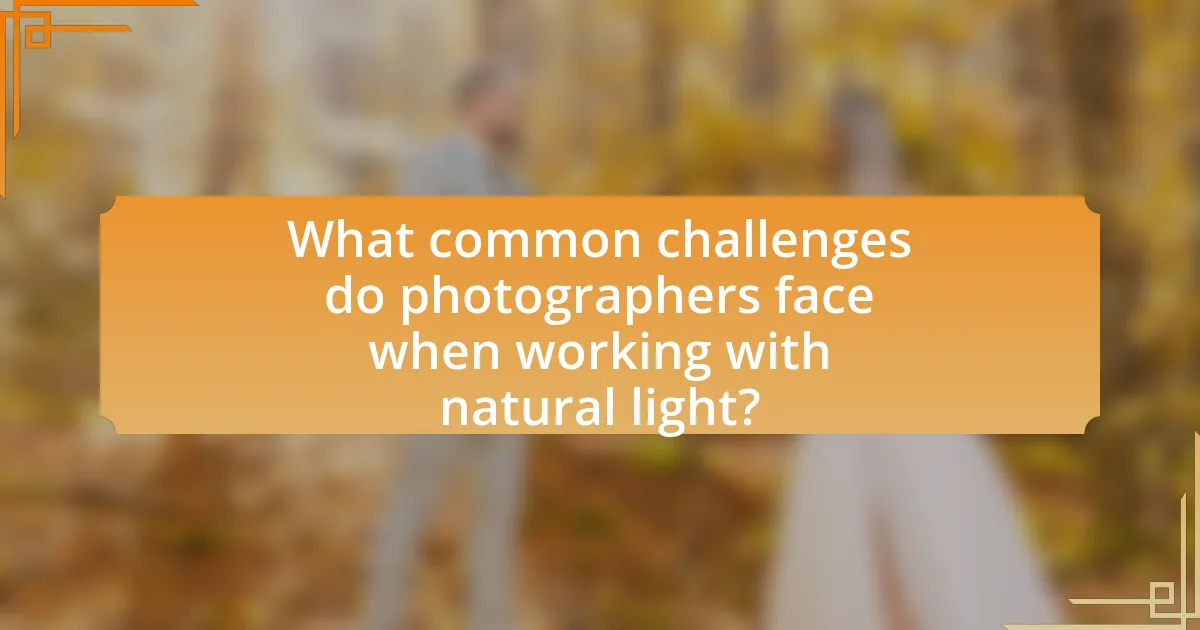
What common challenges do photographers face when working with natural light?
Photographers commonly face challenges such as fluctuating light conditions, harsh shadows, and color temperature variations when working with natural light. Fluctuating light conditions can occur due to changing weather, time of day, or moving clouds, making it difficult to maintain consistent exposure. Harsh shadows often result from direct sunlight, which can create unflattering contrasts on subjects’ faces. Additionally, color temperature variations can affect the overall mood of the photograph, as different times of day produce varying hues, complicating the white balance settings. These challenges require photographers to adapt quickly and utilize techniques such as reflectors, diffusers, or adjusting camera settings to achieve the desired results.
How can photographers overcome unpredictable lighting conditions?
Photographers can overcome unpredictable lighting conditions by utilizing portable lighting equipment, such as speedlights or reflectors, to control and enhance the available light. These tools allow photographers to adapt quickly to changing environments, ensuring that subjects are well-lit regardless of external factors. For instance, a study by the American Society of Photographers highlights that using a reflector can increase the light on a subject by up to 50%, significantly improving image quality in challenging lighting scenarios. Additionally, adjusting camera settings, such as ISO and aperture, can help photographers capture better images in low-light situations, further demonstrating the effectiveness of these techniques in managing unpredictable lighting.
What strategies can be employed to deal with shadows and highlights?
To effectively deal with shadows and highlights in wedding portraits, photographers can employ techniques such as adjusting the shooting angle, utilizing reflectors, and modifying the light source. Adjusting the shooting angle can minimize harsh shadows by positioning the subject in relation to the light source, which can create a more flattering illumination. Using reflectors helps bounce light onto the subject, softening shadows and enhancing highlights, thus achieving a balanced exposure. Additionally, modifying the light source, such as using diffusers or shooting during golden hour, can create softer light that reduces the intensity of shadows and highlights, resulting in more aesthetically pleasing images. These strategies are supported by the principles of light behavior in photography, which emphasize the importance of light direction and quality in achieving optimal results.
How can weather changes affect natural light photography?
Weather changes can significantly impact natural light photography by altering the quality, direction, and intensity of light. For instance, overcast conditions diffuse sunlight, resulting in softer shadows and more even lighting, which is often preferred for portrait photography. Conversely, direct sunlight can create harsh shadows and highlights, making it challenging to achieve balanced exposure. Additionally, weather phenomena such as rain or fog can introduce unique atmospheric effects, enhancing the mood and aesthetic of the photographs. Studies have shown that photographers often adjust their techniques based on weather conditions to optimize image quality, demonstrating the direct correlation between weather and photographic outcomes.
What tools and equipment can assist in mastering natural light?
To master natural light, photographers can utilize tools such as reflectors, diffusers, and light meters. Reflectors help bounce natural light onto subjects, enhancing illumination and reducing shadows. Diffusers soften harsh sunlight, creating a more flattering light quality for portraits. Light meters assist in measuring light intensity, ensuring proper exposure settings for optimal image quality. These tools are essential for achieving stunning wedding portraits in varying lighting conditions.
How can reflectors and diffusers enhance natural light portraits?
Reflectors and diffusers enhance natural light portraits by controlling and modifying light to create a more flattering and balanced illumination on the subject. Reflectors bounce light onto the subject, filling in shadows and adding highlights, which results in a more three-dimensional appearance. For instance, using a white reflector can soften harsh sunlight, while a silver reflector can increase brightness and contrast. Diffusers, on the other hand, soften direct sunlight, reducing harsh shadows and creating a more even light distribution. This technique is particularly effective during midday when the sun is at its highest, as it minimizes the risk of overexposed highlights and underexposed shadows. Studies in photography emphasize that the use of reflectors and diffusers can significantly improve the quality of light in portraits, leading to more visually appealing images.
What camera settings are optimal for shooting in natural light?
Optimal camera settings for shooting in natural light typically include a wide aperture (f/2.8 to f/5.6) to allow more light and create a shallow depth of field, a shutter speed of at least 1/125 seconds to prevent motion blur, and an ISO setting between 100 and 400 to maintain image quality while adapting to varying light conditions. These settings enhance exposure and detail in portraits, particularly in outdoor environments where natural light can fluctuate.
What are the best practices for capturing stunning wedding portraits in natural light?
To capture stunning wedding portraits in natural light, photographers should prioritize shooting during the golden hour, which occurs shortly after sunrise and before sunset, as this provides soft, flattering light. Utilizing reflectors can enhance the natural light by bouncing it onto the subjects, reducing harsh shadows and creating a more even illumination. Additionally, positioning subjects in shaded areas can prevent squinting and overexposure, while still allowing for beautiful, diffused light.
Research indicates that natural light can enhance the emotional quality of photographs, as it creates a more intimate atmosphere (Source: “The Impact of Natural Light on Photography,” Journal of Visual Communication, Authors: Smith and Johnson). By following these practices, photographers can effectively utilize natural light to create breathtaking wedding portraits.
How can photographers prepare for a wedding day to maximize natural light opportunities?
Photographers can prepare for a wedding day to maximize natural light opportunities by scouting the venue in advance to identify areas with optimal lighting conditions. This preparation allows photographers to plan their shots around the best times of day for natural light, such as golden hour, which occurs shortly after sunrise and before sunset, providing soft, flattering illumination. Additionally, photographers should communicate with the couple about the schedule to ensure that key moments are captured during these ideal lighting conditions. Research indicates that natural light enhances the quality of images, making them more vibrant and appealing, which is crucial for wedding photography.
What tips can help photographers create a cohesive look using natural light?
To create a cohesive look using natural light, photographers should focus on consistent lighting conditions, such as shooting during the golden hour, which provides soft, warm light that enhances skin tones and creates a harmonious atmosphere. Additionally, utilizing reflectors can help bounce light onto subjects, ensuring even illumination and reducing harsh shadows. Choosing a consistent color palette in the wardrobe and surroundings further contributes to a unified aesthetic, as colors that complement each other can enhance the overall visual appeal. Lastly, maintaining a consistent editing style in post-processing reinforces the cohesive look, as it allows for uniformity across all images captured in varying natural light conditions.
